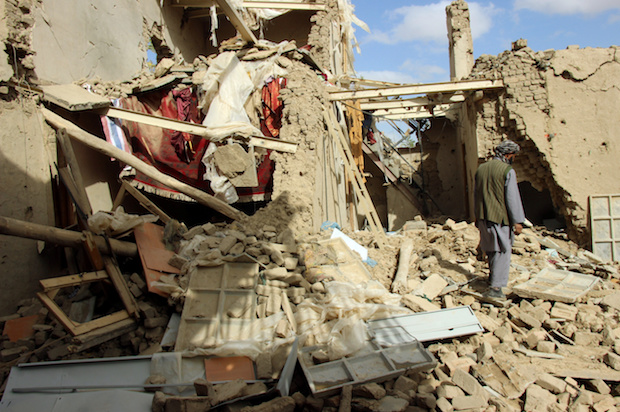At least 30 civilians, including women and children, were killed in NATO airstrikes in Afghanistan on Thursday. Dozens more civilians were wounded.
The site of the attack, in Afghanistan’s northern Kunduz province, was near the remnants of a hospital bombed by NATO forces almost exactly one year before.
These new casualties come just after the U.S.-led war in Afghanistan entered its 16th year. The ongoing conflict, which gets little coverage in the media and has hardly been mentioned in the presidential campaigns, is one of the longest conventional wars in U.S. history, and has taken an enormous toll on the South Asian country’s civilian population.
Airstrikes were called in on Thursday after heavy fighting erupted between Taliban militants and U.S. and allied Afghan forces in the northern village of Buz Kandahari.
Kunduz Governor Asadullah Amarkhil called the attack “a horrible incident,” Reuters reported. Afghan villagers brought the bodies of the slain civilians into the nearby city of Kunduz and held angry protests.
“These bodies you see here are either children or women, they are not Taliban. All innocent children and women killed here — look at the bodies there,” a resident told Reuters.
Two U.S. soldiers were also killed in the fighting.
This latest attack took place roughly three miles from the center of Kunduz, where NATO forces bombed a hospital operated by Doctors Without Borders in October 2015.
Last year’s attack killed another 30 civilians, including 14 hospital workers. A hospital nurse said there “are no words for how terrible” the bombing was, noting that “patients were burning in their beds.”
The U.S. military’s version of the story changed multiple times, and was full of contradictions. Ultimately, no U.S. officials lost their jobs because of the attack.
Doctors Without Borders called the hospital bombing a war crime. The U.N. high commissioner for human rights similarly said it could have been a war crime.
The medical humanitarian group, known internationally as Médecins Sans Frontières, or MSF, emphasized that it had “communicated the precise locations of its facilities to all parties on multiple occasions over the past months.” Yet its facility was repeatedly bombed for more than 30 minutes, even after MSF “frantically phoned” Washington.
The Kunduz hospital was the only large medical facility in all of northeastern Afghanistan, yet MSF was forced to withdraw from the area after the attack.
Millions of Afghans have had their lives permanently changed by the U.S. war, which marked its 15th anniversary on Oct. 7 — an unpropitious date that came and went with little attention in the media, and virtually no acknowledgment by major American politicians.
More than a decade of nonstop war has pushed Afghanistan to the brink of catastrophe. And things are getting worse, not better.
At least 220,000 Afghans were killed in the first 12 years of the war, in a conservative estimate, according to a report by the Nobel Prize-winning organization International Physicians for the Prevention of Nuclear War.
Since 2012, Afghan civilian casualties have increased, with children making up a growing portion of victims. The violence in 2015 was the worst since the U.N. began tracking the casualties.
In the first nine months of 2016, 2,562 Afghan civilians were killed, including more than 600 children, and another 5,835 were injured, according to the U.N. Assistance Mission in Afghanistan.
A graph released by the U.N. mission shows how civilian casualties have gradually risen in the past several years.

A May report by Amnesty International noted that the number of Afghans “who have fled violence and remained trapped in their own country, where they live on the brink of survival,” has doubled in just over three years.
At least 1.2 million Afghans are displaced within their country — a rise by some 240 percent since 2013. Another roughly 2.6 million Afghans are refugees, stuck outside of their country’s borders.
Afghans make up one of the world’s largest refugee populations. Yet the European Union, which has backed the NATO war in Afghanistan that has displaced so many people, made a deal to send Afghan refugees to Turkey, in a plan experts said is illegal and immoral.
Even child refugees are not spared. From 2007 to 2015, the United Kingdom deported 2,018 unaccompanied children to Afghanistan — in another program human rights officials have warned is illegal.
None of this is to mention the enormous costs of the war for U.S. taxpayers. Numerous reports estimate that the war in Afghanistan has cost at least $1 trillion. That is money that could have been invested in social services, health care, infrastructure, education and so much more.
The war drags on. President Obama promised countless times that he would end it in 2014. Instead, he has extended it multiple times.
The Taliban was itself a product of U.S. war. In order to fight the Soviet Union in Afghanistan in the 1980s, the U.S. and its allies Pakistan and Saudi Arabia trained, armed and funded extremist Islamist militants, giving birth to the extremism that haunts the region today.
While fighting between the Taliban and U.S.-led forces escalates, Obama nears his last days in office. Neither Hillary Clinton, the most likely candidate for U.S. president, nor her opponent Donald Trump has presented a strategy for ending the war. The Afghan people, meanwhile, cannot wait. They are dying, suffering, losing their homes and loved ones.
As Nicholas Haysom, the U.N.’s secretary general’s special representative for Afghanistan, put it in February, mere statistics do not “reflect the real horror of the phenomenon we are talking about.”
“The real cost we are talking about in these figures,” Haysom continued, “is measured in the maimed bodies of children, the communities who have to live with loss, the grief of colleagues and relatives, the families who make do without a breadwinner, the parents who grieve for lost children, the children who grieve for lost parents.”

